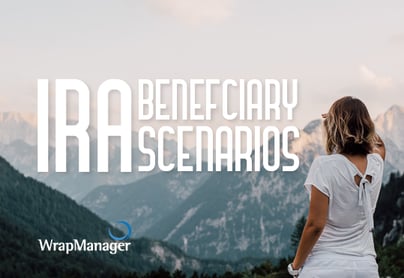 When most investors/retirees think of Required Minimum Distributions (RMDs), they think of turning 70 ½ and having to take mandatory distributions from an IRA. The federal government allows savers to make tax deductible contributions (with tax deferred growth) to IRAs/401(k)s/qualified retirement plans throughout their working lives, but the party ends when folks turn 70 ½. Uncle Sam eventually gets his cut.
When most investors/retirees think of Required Minimum Distributions (RMDs), they think of turning 70 ½ and having to take mandatory distributions from an IRA. The federal government allows savers to make tax deductible contributions (with tax deferred growth) to IRAs/401(k)s/qualified retirement plans throughout their working lives, but the party ends when folks turn 70 ½. Uncle Sam eventually gets his cut.
There’s one feature of RMDs, however, that is less widely known. That is, if the account owner passes away and there is still a balance in the qualified retirement account, it is the responsibility of the beneficiary to take the required distributions, whether that be the spouse, a child, a charity, a trust, and so on. Not taking the required distributions can result in a 50% excise tax penalty on the amount not withdrawn, so it’s important to understand these rules. We’ll break them down more clearly for you, below.
Scenario 1: The IRA Owner Passes Away Before His/Her Required Beginning Date
If the IRA Beneficiary is a Spouse:
If you assume the IRA, you must start making distributions on your required beginning date (i.e., when you turn 70 ½). Assuming an IRA means opting to treat the IRA as if it was your own account.
If you inherit the IRA, you have two options:
Option #1: You must begin taking RMDs based on your own life expectancy by the later of:
- December 31 of the year after the year of the IRA owner's death.
- December 31 of the year in which the IRA owner would've turned 70½.
Option #2: You must draw down the entire account in 5 years, with the entire account redeemed by the end of the 5th year after the year of the IRA owner's death.
If the IRA Beneficiary is a “Qualified Beneficiary”:
Qualified beneficiaries include a spouse who isn't the IRA's only beneficiary, non-spouse beneficiaries, and qualifying trusts.
Option #1: In this scenario, it could be crucial that all beneficiaries establish their own accounts by December 31 of the year after the year of the IRA owner’s death. Doing so means being able to base RMDs on your life expectancy, versus the life expectancy of the oldest beneficiary (which you would have to do if not all beneficiaries have established their own accounts). If the oldest beneficiary is much older than you, the withdrawals – and the tax burden – are likely to be larger.
The RMDs must start by December 31 of the year after the IRA owner’s death.
Option #2: You must draw down the entire account in 5 years, with the entire account redeemed by the end of the 5th year after the year of the IRA owner's death.
If the IRA Beneficiary is a “Non-Qualified Beneficiary”:
Non-qualified beneficiaries are those that are not people, such as charities or organizations, the IRA owner's estate, or non-qualifying trusts.
In this scenario, there is only one option: the entity must draw down the entire account in 5 years, with the entire account redeemed by the end of the 5th year after the year of the IRA owner's death.
Scenario 2: The IRA Owner Passes Away On or After His/Her Required Beginning Date
If the IRA Beneficiary is a Spouse…
If you assume the IRA, RMD calculations are based on your required beginning date.
If the IRA Beneficiary is a “Qualified Beneficiary”:
If you inherit the IRA, you must begin taking RMDs by December 31 of the year following the year the IRA owner passed away. You calculate your RMD based on your life expectancy or the life expectancy of the deceased IRA owner, whichever is longer.
One more note: if the IRA owner passes away and hasn’t yet taken his/her RMD that year, you must take it.
If the IRA Beneficiary is a “Non-Qualified Beneficiary”:
The entity must begin taking RMDs by December 31 of the year following the IRA owner's death, based on the IRA owner's remaining life expectancy. Just like above, if the IRA owner passes away and hasn’t yet taken his/her RMD that year, the entity must take it.
What About Inherited Roth IRAs?
Roth IRA owners don't need to take RMDs during their lifetimes, but beneficiaries who inherit Roth IRAs do. If you're inheriting a Roth IRA, you calculate your required minimum distribution amounts as though the account owner passed away before his or her RBD (see rules above), regardless of the actual date of death.
Need Help Calculating Your RMD, or Unsure if You Must Take One?
We realize the above rules can be complicated, even for people with financial or tax backgrounds! Instead of worrying about making sure you get the RMD correct, why not work with a Wealth Manager here at WrapManager and let us manage the process for you? Not only will we work to ensure you take your RMDs in a timely and accurate manner, we can also help you manage the assets in accordance with your investment objectives. Reach out to us today at 1-800-541-7774 to get the process started, or start a conversation over email at wealth@wrapmanager.com.





